Note: This article is part two of a two-part series. The information it contains is an excerpt from the book "Multi-Site Pig Production" by Dr. Hank Harris, which is being published in November 1999 by Iowa State University Press. Pig333 thanks the publisher for the permission granted to publish the document on this website.
In a previous article (March 1999) we suggested a standardized terminology for the description of swine production systems. The terminology covered stages of production (breeding, nursery, finishing), management practices (isowean, sourcing of pigs, movement of pigs), and physical aspects and geographical locations of production facilities (numbers of buildings, loci, and sites).

The intent for proposing such terminology arose from an effort to facilitate communication among owners, farm managers, veterinarians, service personnel, and lenders regarding the physical and managerial structure of the various swine production facilities.
The term “site” indicates the number of tiers in a production system. The term “locus” (plural loci) was introduced to designate in particular the geographic location and arrangement of buildings within each site of the production system. To complement this terminology and provide a shorthand method for describing such facilities, an alphanumeric notation system and simplified diagrammatic scheme are proposed.
Key to alphanumeric notations
The alphanumeric notation system is designed to stand alone without the use of diagrams or photographs. The notation can be very brief (Figure 1-8, 12) for use as an adjunct to diagrams and photographs or be extremely detailed (Figures 9-11) including information regarding pig throughput and single sex feeding.
Stage of production (SP) - The three stages of production are:
Stage of Production 1 – Production stage in which breeding females and boars are kept and managed for the purpose of producing weaned pigs.
Stage of Production 2 - Production stage associated with nursery pigs.
Stage of Production 3 - Production stage associated with finisher pigs
Arabic numeral(s) after the letters SP refers to the stage or stages of production present at that particular site.
Site (S)– Site indicates the number of tiers of a production system. A written numeral prior to the word site designates the type of production system as in one site, two site, and three site. An arabic numeral following the word site designates a specific tier in the production system as in Site 1, Site 2, and Site 3. Pigs may be housed on one or more locations (loci) within a specific site.
Locus or Loci (L) – Loci indicate the number of geographic locations for each stage of production at each site. There may be one or more buildings at each locus.
Arabic numeral after the letter L refers to the number of loci at each site.
Buildings (B)
Arabic numeral after the letter B refers to the number of buildings at each locus.

Breeding and Gestation (BrGe)
Arabic numerals after the letters BrGe refers to the number of breeding and gestation buildings at each locus.
Farrowing (Fa)
Arabic numerals after the letters Fa refers to the number of farrowing buildings at each locus.
Pre-Nursery (PN)
Arabic numerals after the letters PN refers to the number of pre-nursery buildings at each locus.
Nursery (N)
Arabic numeral after the letter N refers to the number of nursery buildings at each locus.
Grower (G)
Arabic numeral after the letter G refers to the number of grower buildings at each locus.
Finisher (F)
Arabic numerals after to the letter F refers to the number of finisher buildings at each locus.
Nursery Finish Building (NF) - Rearing quarters for pigs ranging in age from 2-3 weeks through slaughter weight. Other terms that have been used for nursery finish buildings are NurFin and wean-to-finish.
Arabic numeral after the letters NF refers to the number of wean-to-finish buildings at each locus.
Hoop or Hut Buildings (H)
/H following the letter B refers to the use of hoop or hut buildings at each locus; a numeral can also be used to designate the number of buildings per locus at each site
All-in all-out (AIAO)
The letters AIAO refer to the use of all-in all-out pig flow.
The / symbol following the letters AIAO and then followed by one of these letters: R=room; B=building; or L=locus indicates if the pig flow is all-in all-out by room, building or locus.
Continuous Pig Flow (CF)
The letters CF refer to use of continuous pig flow.
The / symbol following the letters CF and then followed by one of these letters: R=room; B=building; or L=locus indicates if the pig flow is continuous flow by room, building or locus.
On-locus well separated buildings (Ø)
The Ø symbol indicates buildings on a locus that are separated by more than 100 yards and/or by placement directly across from a waste storage lagoon.
Global Positioning System (GPS)
The letters GPS followed by latitude and longitude coordinates in brackets [ ] indicates the geographic position of either a structure within a locus or the locus itself.
Diagrams
Diagrams of production systems may be used alone or as an adjunct to alphanumeric notation.
As with alphanumeric notation, diagrams may be extremely detailed or rather simple depending upon their purpose or use.
Diagrams are in black (or one color) and white (using various shades and stippling) for depiction of the age of pigs in the various stages of production. Clear white is used for structures not containing pigs, light shade indicates newborn piglets, medium shade indicates growing pigs and black (or darkest shade) indicates adult swine (Figure 13). In some cases, it may be necessary to use abbreviations to denote specific structures such as isolation buildings (IB) and boar studs (BS).
The alphanumeric notation can be used in diagrams to indicate such things as weaning age, throughput, number of pigs per room, building or locus, GPS coordinates, and single sex feeding.
Examples of alphanumeric notation and diagrams
 Adults Adults Nursery Nursery Locus Locus |
 Adults + lactation Adults + lactation Finishing Finishing Facilities without pigs Facilities without pigs |
One site production
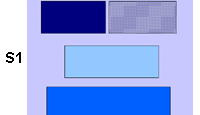 |
S1 = SP1-2-3, L1 Stages of production 1, 2, and 3 are on one site |
Traditional two site production (single source, single locus)
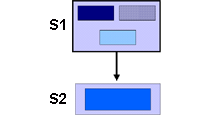 |
S1 = SP1-2, L1; S2 = SP3, L1 Stages 1 and 2 are on one locus within site 1; stage 3 is on one locus within site 2. |
Traditional two site production (multiple sources, single locus)
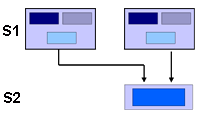 |
S1 = SP1-2, L2; S2 = SP3, L1 Stages 1 and 2 are on more than one locus (multiple source feeder pigs) within site 1; stage 3 is on one locus within site 2 |
Two site Isowean production (single source, single locus)
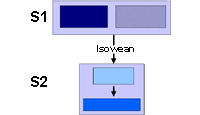 |
S1 = SP1, L1; S2 = SP2-3, L1 Stage 1 is on one locus within site 1; stages 2 and 3 are on one locus within site 2 |
Two site Isowean production (multi-source, multi-loci)
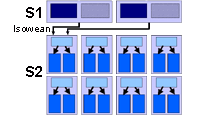 |
S1 = SP1, L2; S2 = SP2-3, L8, B3[1N,2F] Stage 1 is in two loci within site 1 (multi-source); stages 2 and 3 are on 8 loci within site 2. There are 3 buildings per locus (one nursery and 2 finishers) per locus at site 2. |
NurFin Isowean production (single source, multi-loci)
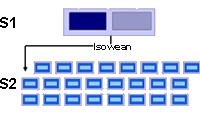 |
S1 = SP1, L1; S2 = SP2-3, L24, NF1 Stage 1 is on one locus within site 1; stages 2 and 3 are combined within one building on 24 isolated loci within site 2 |
NurFin Isowean production (single source, multi-loci)
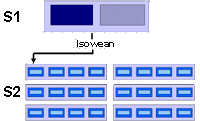 |
(S1=SP1,L1;S2=SP2-3,L6,NF4 Stage 1 is on one locus within site 1; stages 2 and 3 are in 6 loci within site 2. There are four NurFin buildings per locus |
Three site production (single source, single locus)
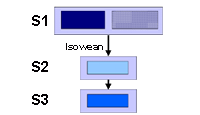 |
S1=SP1,L1;S2=SP2,L1:S3=SP3,L1 |
Alphanumeric notation and diagram indicating the stages of production on three sites but without other details regarding number of buildings per locus, etc. (Compare to the three previous figures).
Three site production (single source, single locus)
|
Alphanumeric notation and diagram indicating very detailed information including the nature of the facilities, numbers of pigs housed, location of the loci, waste handling system, and pig flow (compare to the previous figure). GM, S1=SP1, L1 [NS=2000]; S2=SP2, L1[B=17, NP=6,000]; S3=SP3, L1 [NP=16,000] The farm is a gilt multiplier (GM) with the first stage of production (SP) on site 1, the second stage on site 2 and the third stage on site 3. Each site has one locus (L). There are 2000 sows (NS) at site 1, 6,000 pigs (NP) at site 2 that are being weaned at 17 days of age (WA=weaning age), and 16,000 pigs at site 3 (NP). The Global Positioning System (GPS) coordinates are given for the location of each site. |
|
 |
Site 1 (GPS = 42º 03' N - 93º 51' W) Site 1 has 12 buildings (B) including two offices (FF) and showers (S), two incinerators (I), 4 Breeding (Br) and Gestation (Ge) buildings that are curtain sided (CS). The pig flow in the four farrowing (Fa) rooms is all-in; all-out (AIAO) by room (R) and the farrowing rooms are power ventilated (PV). All the buildings with pigs have deep pits (DP). |
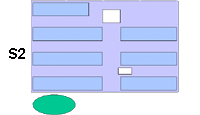 |
Site 2 (GPS = 42º 00 'N - 93º 37' W) Site 2 has nine buildings including one office and shower facility, one incinerator (I), four pre-nursery (PN) buildings and three nursery (N) buildings that are all-in; all-out by room and power ventilated. The pig buildings have shallow pits (ShP), fresh water flush (FWF) and a lagoon (Lag). |
 |
Sitio 3 (SGP=42º 26' - 93º 52' O) N18 (1OOD, ACT, 5Cr[TDTF/N, CL] 11C[TDTF/N, CL, SMH][De, ARP, Bp] 1MC) El sitio 3 tiene 18 naves que comprenden una oficina y ducha (OOD), un área de almacenamiento de cadáveres y transporte (ACT). Las 5 naves de crecimiento (Cr) y las 11 naves de cebo (C) están separadas por cortinas (CL). El flujo de cerdos en las naves de crecimiento y cebo es en grupos por nave (TDTF/N), con los cerdos sepados por sexo (SMH=separación de machos y hembras). Los desagües (De) de las naves para cerdos se lavan con agua reciclada de la balsa a presión (ARP). En el sitio 3 hay una nave de carga (MC=muelle de carga) |
Three site production (multi-source, multi-loci)
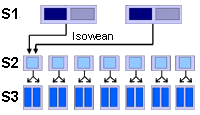 |
S1=SP1,L2;S2=SP2,L8[AI,AO],B1; S3=SP3,L8[AI,AO],B2 Stage 1 production is on more than one loci within site 1; stage 2 is on more than one loci within site 2; stage 3 is on more than one loci within site 3 |
Acknowledgements: The authors appreciate the suggestion by Dr. Steve Henry for the use of the Global Positioning System. Dr. Joe Connor presented the NurFin design for site 2 in Figure 7 at the Leman Conference in 1998. The authors are greatly indebted to Drs. Bob Glock, Barry Wiseman, and Bill Christianson for their comments and encouragement.



